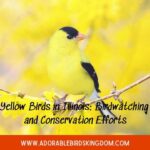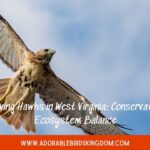I’ve always been captivated by the sight of falcons soaring in the Iowa skies. These majestic birds are a testament to the state’s rich biodiversity. As a native Iowan, I’m proud to share some of the fascinating facts about our local falcon population.
Falcons in Iowa are a sight to behold. They’re not just beautiful, but they’re also an integral part of our ecosystem. From the Peregrine Falcon, known for its breathtaking speed, to the American Kestrel, the smallest falcon species in North America, Iowa is a haven for these incredible creatures.
But there’s more to these birds than meets the eye. They have unique characteristics and behaviors that set them apart from other bird species. So, let’s take a closer look at falcons in Iowa and uncover what makes these birds so special.
The Majestic Falcons of Iowa
Iowa’s skies are a testament to its rich biodiversity, with falcons emblematic of this variety. The likes of Peregrine Falcons and American Kestrels lend an air of majesty that can captivate any bird enthusiast’s attention.
Each dawn, as daylight pierces the quiet night, you’ll witness these creatures unfurl an explicit dance high above. Their sleek wings cut across the crisp Iowa air, outlining a meticulous balance of power and elegance. It’s an embodiment of nature’s sheer beauty, and one that doesn’t fail to keep me entranced.
Here, you’ll find the world’s most formidable aerial predator, the Peregrine Falcon. Noted for its remarkable speed, it’s recorded as hitting over 240 mph in its hunting stoop – making it the world’s fastest bird. I’ve found it quite thrilling to watch these birds soar through the skies in pursuit of prey.
Not to be overshadowed, American Kestrels hold a unique charm of their own. They’re small yet fiercely independent. With their vibrant plumage and adept hunting skills, they’re essentially visual treats that add a dash of color to Iowa’s grey winter canvases.
I also can’t disregard how falcons have ingrained themselves in the very fabric of Iowa’s ecosystem. They are officially recognized as key biological controls, keeping the populations of troublesome pests in check.
In the table below, I’ve summed up some key facts about these falcons from Iowa:
| Fact | Peregrine Falcon | American Kestrel |
|---|---|---|
| Population in Iowa | 100 Pairs | 1500 Pairs |
| Top Speed | 240 mph+ | 60 mph |
| Status | Least Concern | Least Concern |
The magic of falcons extends beyond their exterior aesthetics, delving straight into their ecological significance. So, when you peer out at the Iowa sky and catch the blurred silhouette of a falcon in mid-flight, remember to admire not just its finesse but its role in the wheel of life. And know that you’re amid one of nature’s most compelling theatre plays.
Importance of Falcons in Iowa’s Ecosystem
Falcons play an invaluable role in Iowa’s ecosystem. As powerful predators, they’re crucial in maintaining biodiversity by controlling pest populations. Their speed and nimbleness make them lethal hunters, capable of swooping on unsuspecting prey with deadly precision. It’s by no means a stretch to label falcons as Iowa’s natural pest control.
Let’s take the Peregrine Falcon, for example. With a top speed exceeding 240 mph, they dominate the sky, keeping check on populations of smaller birds and rodents. Such hunting prowess deters overpopulation of species, which in turn prevents the depletion of food resources.
Another incredible species to highlight is the American Kestrel. Owing to its vibrant plumage and phenomenal hunting skills, it’s a sight to behold. But beyond their outward allure, they exhibit an active role in pest control. Famously, they feed on insects, small mammals, and occasionally, birds. This helps to manage the populations of these creatures, particularly insects, a lot of which are acknowledged as pests.
But it’s not just about pest control. Falcons also contribute to the process of natural selection. They target the weak, sick or slower individuals in a population. In turn, the more robust, healthier, quicker individuals have a higher survival rate, allowing these traits to be passed on to next generations.
Their presence and activity in Iowa’s ecosystem extend to influencing the behavior and distribution of other species. Their hunting patterns can cause shifts in the habitats and behavior of their prey, encouraging a diverse range of adaptions and supporting biodiversity.
So, next time you see these marvelous creatures ruling the sky, remember they’re not just part of the view. They’re busy fulfilling crucial roles in the grand scheme of Iowa’s natural world. Keep watching, as their elegant flights and riveting hunting pursuits tell the tale of their significant ecological impact in a way that’s nothing short of captivating.
Diversity of Falcon Species in Iowa
It’s astounding to learn about the diversity of falcon species found in Iowa. They impart a unique flavor to the ecology of this region. Did you know, for instance, that the Iowa falconry scene is enlivened by multiple species each having a distinct role in maintaining balance in our ecosystem?
One such species is the Peregrine Falcon. These avian predators are not just fast; they’re among the fastest creatures on planet Earth! They’ve been observed diving for prey at astounding speeds surpassing 240 mph. Their specialty? Hunting mid-air! Birds form a majority of their diet, and they have no problem diving through the air to get their meal. By controlling the bird population, these falcons ensure a balanced ecosystem in Iowa.
Let’s get acquainted with a smaller member of the falcon family: the American Kestrel. Don’t be fooled by their size, though. They are skilled predators, feeding on insects, small mammals, and sometimes even small birds. Their varied diet includes critters that are often seen as pests, making them a farmer’s best friend!
Another interesting species found in Iowa is the Merlin, a medium-sized falcon characterized by its agility. It prefers to feast on small birds and insects, which they catch in mid-flight. Their distinctive hunting style makes them a joy to observe in action.
It’s significant to acknowledge the role of these falcons in preserving the biodiversity of Iowa. The hunting habits of these falcons have a direct impact on the local wildlife, right down to the insect populations. By controlling these numbers, they ensure a fine balance is maintained between different species, indirectly supporting the survival and propagation of other creatures. It’s fascinating to note how each falcon species has found its own unique niche within the ecosystem, contributing to its health and diversity.
Falcons in Iowa are a testament to the region’s diverse and thriving ecology. Their presence here is more than a mere show of nature’s grandeur — it’s a demonstration of the interwoven, cyclical nature of life.
Unique Characteristics and Behaviors of Iowa Falcons
Let’s dive deeper into the unique characteristics and behaviors of the three primary Falcon species found in Iowa: The Peregrine Falcon, the American Kestrel, and the Merlin.
Peregrine Falcons, known for their speed, soar to great heights. They’ve been clocked reaching speeds of up to 242 mph while hunting. One might wonder at the purpose of such incredible speed. It’s quite simple. This spectacular speed enables them to swoop down from a great height and surprising their prey, typically pigeons and ducks, both of which form a significant part of their diet. This mid-air hunting strategy sets them apart in bird kingdom.
On the other hand, the American Kestrel, the smallest Falcon species in North America, prefers a rather grounded approach to hunting. They perch on branches or power lines, keeping their sharp eyes peeled for any movement. Feeding on pests such as insects, rodents, and small birds, they’ve become nature’s very own pest controller.
Last but certainly not least is the Merlin, a small falcon similar in size to the American Kestrel. Characterized by their dark color and robust body structure, Merlins are expert hunters, preying on small birds and insects. Aggressive in nature, they’re known to drive away larger birds from their territories.
These Falcons are not merely predators but paramount players in maintaining the ecosystem balance. Their hunting helps control and regulate the number of other animals, ensuring a balanced distribution of species and contributing to biodiversity in the region. However, it’s essential to remember that each of these species faces various threats and challenges, contributing to their population decline in the state. The responsibility of their conservation and sustainability lies with us.
In delving into their individual characteristics, a pattern becomes clear: each of these species has honed their lifestyle and hunting strategies to environmental conditions, contributing uniquely to the ecological balance of Iowa. The interplay between these species in the state’s ecosystem serves as a testament to the intricate interconnectedness of nature.
Conservation Efforts for Falcons in Iowa
Preserving falcon species in Iowa is no walk in the park. Deforestation, climate change, and urbanization pose monumental challenges. But conservation bodies and local communities don’t flinch from these challenges. They’ve rallied together to enact significant change, demonstrating that survival and growth for these birds are indeed achievable.
Several programs have been put in place to conserve the Peregrine Falcon, American Kestrel, and Merlin populations in the state. The implementation of breeding and release programs has been a significant game changer. By increasing the number of falcons in safe, controlled environments, it’s been possible to boost population numbers with relative success.
| Falcon Species | Breeding Program Success | Number Released Annually |
|---|---|---|
| Peregrine Falcon | High | 30-40 |
| American Kestrel | Moderate | 20-30 |
| Merlin | Low | 10-20 |
Education and community engagement also play vital roles in conservation efforts. This helps in breeding awareness and in creating safe habitats across Iowa. Integrating falcon conservation into school curriculums and organizing community events have been fruitful strategies. Who knew the younger generation could be conservation warriors?
Another noteworthy method has been the installation of “nesting boxes” in urban areas. These nesting boxes replicate the cliff-side habitats that Peregrine Falcons favor. They’ve also assisted the American Kestrel and Merlin populations by providing safe havens in otherwise dangerous city areas.
But let’s not rest on our laurels yet. While these efforts have borne fruit, the fight to conserve Iowa’s falcons is an ongoing battle. As threats evolve, so too should our strategies and commitment to preserve these incredible birds. Every Iowa resident can chip in to these efforts, ensuring a thriving, diverse ecosystem in our cherished state.
Conclusion
Iowa’s falcons have faced numerous challenges but have also seen significant strides in their conservation. The commendable efforts of breeding programs, community engagement, and urban nesting boxes have all contributed to the resurgence of these majestic birds. Yet, it’s clear we can’t rest on our laurels. The fight against deforestation, climate change, and urbanization continues. The survival of Peregrine Falcons, American Kestrels, and Merlins in our state depends on our unwavering commitment to their preservation. Let’s continue to champion these conservation efforts, ensuring the skies of Iowa remain home to these remarkable falcon species.



